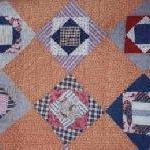America's Quilting History
Civil War Quilting for Fundraising and Soldiers

When the Civil War broke out in 1861 Union and Confederate women rallied to the war effort ready and eager to help out in any way they could. Patriotic fervor abounded with both sides certain the war would be short and decisive.
Great fairs were held in the north and quilts were among the more expensive items made and donated. Craft bazaars were already a way to raise funds for churches and other causes. Now that effort went to the war.
Although there were some who frowned on the idea of women being involved in any commercial venture patriotism won out as fairs became more and more elaborate. Women created beautiful quilts often of silk. Album quilts and Flag quilts were popular styles. There is even mention of silk Log Cabin quilts. These fairs brought in a great deal of money to help buy needed supplies for the Union.
Southern women did what they could to help buy desperately needed gunboats. Excitement was high as communities competed to raise money for this urgent cause. Beautiful Gunboat Quilts* were made. Some of these displayed elaborate medallion style floral arrangements cut from printed fabric. The motifs were cut out and appliquéd to solid fabric. This method is called broderie perse and requires very fine needlework skills. Through fairs, raffles and donations southern women raised enough money to pay for three of these ironclad gunboats.
During the spring of 1862 the enthusiasm for this confederate project waned when naval defeats made it likely that seaports would fall to the enemy. It was decided that the funds should go for medical supplies for soldiers instead. The war would continue for three desolating years with southern women's energy going primarily to help their soldiers.
Unfortunately the war that was supposed to "only spill a thimble-full of blood" drug out over four devastating years. It soon became obvious that there was a desperate need for clothing and blankets for the soldiers.
 Northern women were accustomed to gathering together and sewing for a cause. Church and abolitionist groups simply changed their focus to helping soldiers. Many thousands of soldier's aid societies were formed. An organization called the Sanitary Commission was established to do what was possible to prevent the death of soldiers from disease and injury. As the urgent need for soldier's bedding became apparent the Sanitary Commission added the collection and distribution of donated quilts and comforts to their activities.
Northern women were accustomed to gathering together and sewing for a cause. Church and abolitionist groups simply changed their focus to helping soldiers. Many thousands of soldier's aid societies were formed. An organization called the Sanitary Commission was established to do what was possible to prevent the death of soldiers from disease and injury. As the urgent need for soldier's bedding became apparent the Sanitary Commission added the collection and distribution of donated quilts and comforts to their activities.
At first family quilts were donated but very quickly women began to produce quilts specifically for the war effort. The military had requested that quilts be made about seven feet by four feet, the convenient size for a military cot and bedding pack. Many quilts were made from available fabrics and sometimes three cot quilts were made from two existing bed quilts. Eventually money had to be raised to buy the materials to make soldier's bedding as existing materials were used up. By the end of the war it is estimated that over 250,000 quilts and comforts had been made for Union soldiers.
Southern women were somewhat hindered in producing bedding for soldiers because they did not have a tradition of sewing for causes and the wealthier women were used to having slaves to do the everyday sewing. Nevertheless many of these women learned to sew and pitched in to help their soldiers. Once prewar textiles were used up fabric became scarce. The south could not get goods in through their ports and had no real manufacturing base of their own. Calico was said to cost as much as $25 a yard toward the end of the war. Eventually women had to make homespun fabric, a much slower process. Old mattresses were torn apart for fiber to spin. Even carpets were cut up and made into blankets for soldiers.
Just a very few of the quilts made for soldiers have survived. As you can imagine these quilts got a great deal of wear and probably did not seem worth saving after the war. Many completely wore out. If you add to that the fact that many soldiers were buried in their quilts you can understand why these quilts are extremely rare today.
© 2001 Judy Anne Johnson Breneman (Do not reproduce any material from this site without permission.)
*To view a photograph of an actual Gunboat Quilt from the Birmingham Museum of Art click on the thumbnail labeled "Quilt, 1861 cotton, silk, taffeta".
References:
"Quiltmaking in America: Beyond the Myths", Laurel Horton (Editor)
"Quilts from the Civil War", by Barbara Brackman


